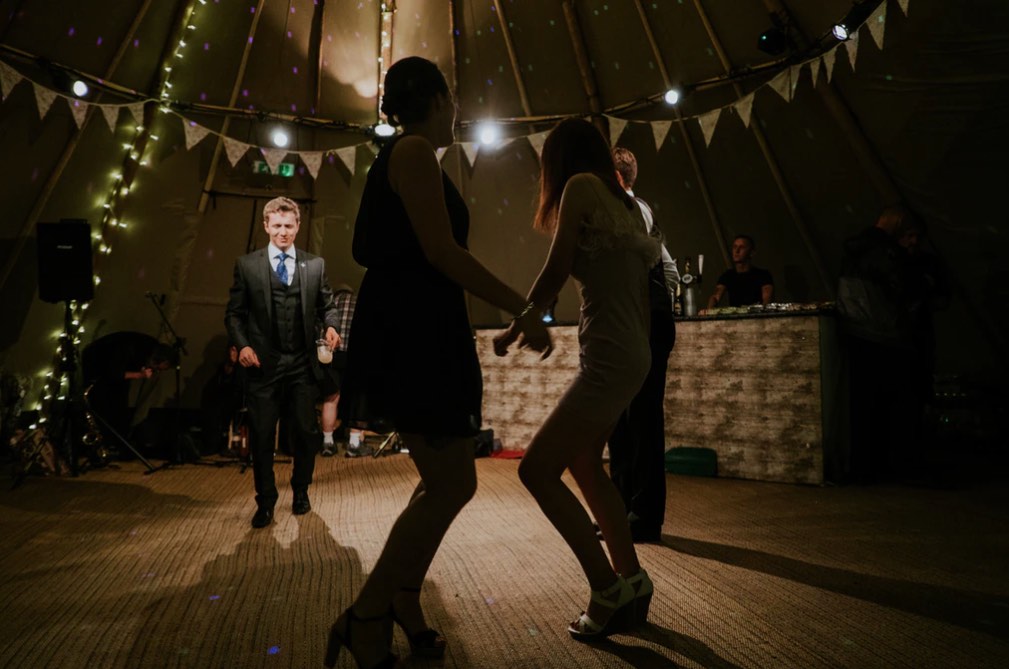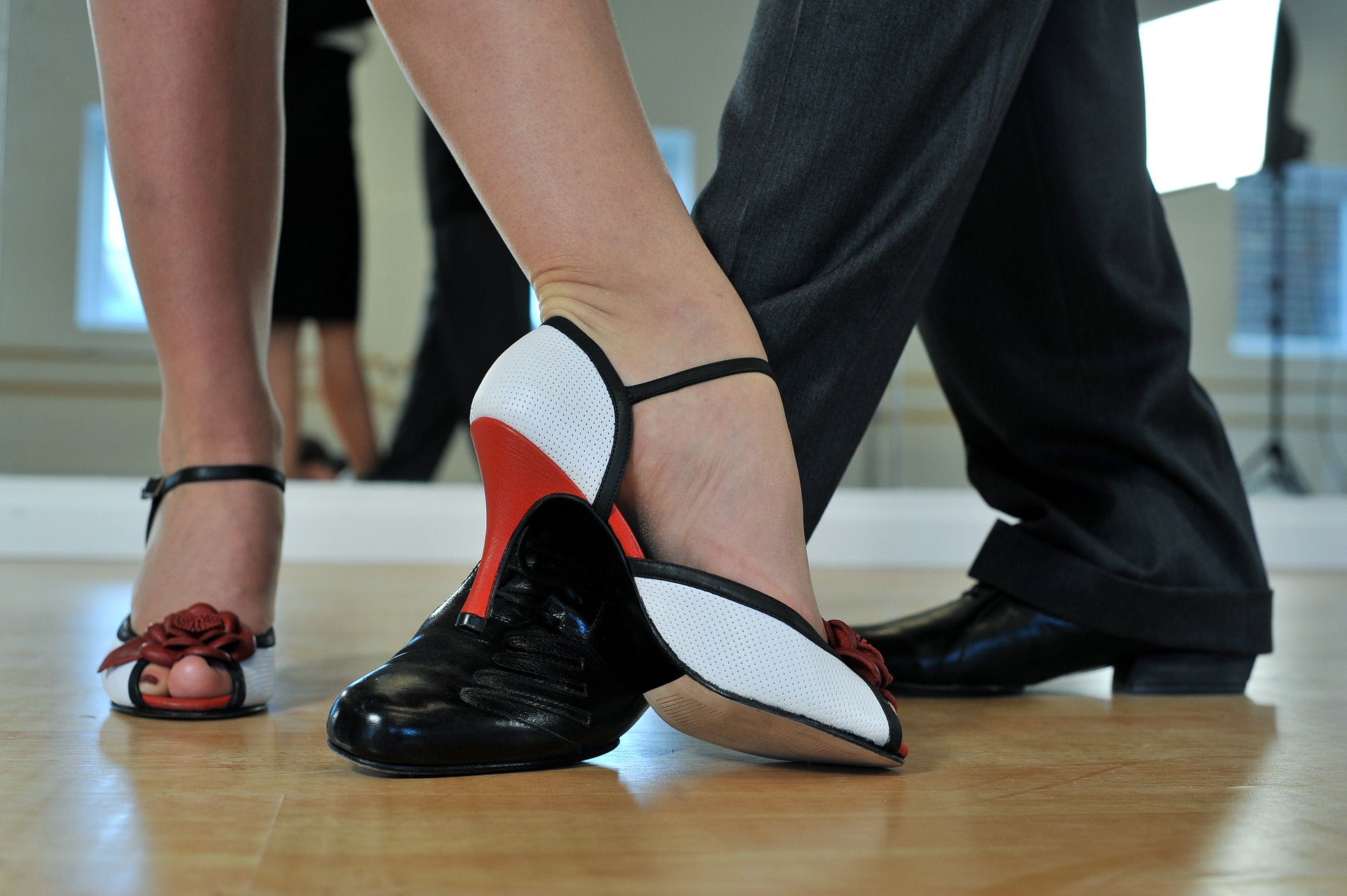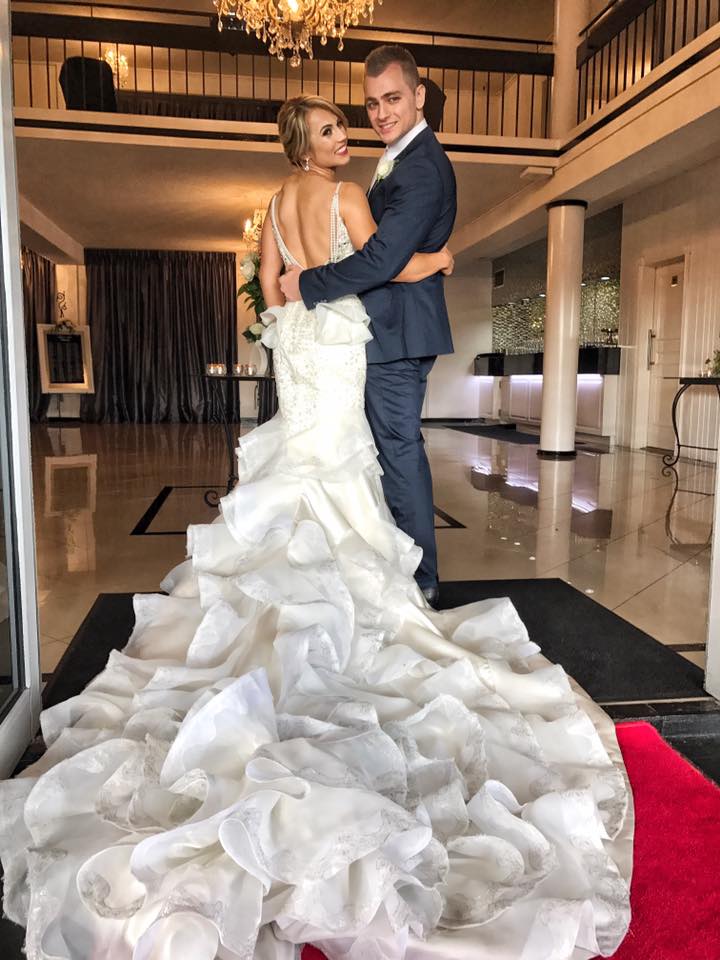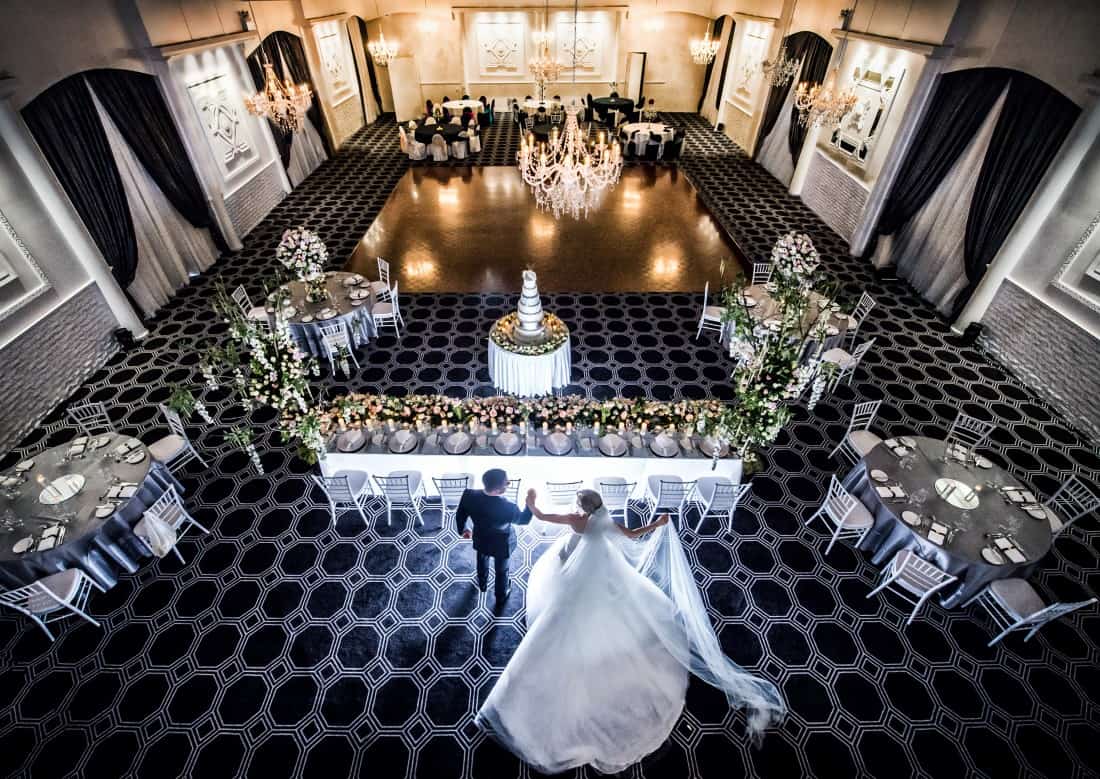Weddings are full of special moments, but there’s something uniquely magical about the dances. Whether it’s your first dance as newlyweds, the heartfelt parent dances, or even the fun wedding party shuffle, these traditions bring your celebration to life. But with so many dances to fit in, you may be wondering: which dance comes first?
Having worked with hundreds of couples at Vogue Ballroom, I’ve seen firsthand how the order of wedding dances can set the tone for the entire reception. It’s more than just timing—it’s about creating a flow that feels natural, emotional, and fun for everyone involved.
The right sequence of dances can help make your wedding feel seamless, from the romantic first dance to the lively guest involvement later on. We’ll explore the traditional dance order, ways to personalise it, and share tips on song selection, choreography, and more to make sure everything runs smoothly.
The Tradition Behind Wedding Dances: Why the First Dance is Special
Wedding dances are one of the most memorable parts of any celebration, and the first dance is usually the showstopper. I remember when my partner and I danced at Vogue Ballroom during our wedding—it was that perfect moment where everything else faded away, and it was just the two of us.
For couples I’ve worked with, this moment often feels like the culmination of months of planning, not to mention the nerves about performing in front of everyone.
A Look at the Origins of the First Dance
The tradition of the first dance dates back to 17th-century Europe, where royalty would open a ball by taking the floor first, symbolising their leadership. Over time, this evolved into a moment for the bride and groom to showcase their unity and mark the start of their married life together. It’s a deeply symbolic gesture that sets the tone for the rest of the evening, from the music to the mood.
The Symbolism of the First Dance in Today’s Weddings
The first dance today still carries that same sense of significance, but now it’s also about the couple’s journey. It’s not just about the steps you take together; it’s about the story you want to tell through that dance. Whether it’s a slow, romantic number or something with a little more flair, this moment symbolises the start of your new life together. I’ve seen couples choreograph entire routines, adding their personal touch, and those moments are always memorable for everyone in the room.
For some couples, this can be an emotional moment where the nerves melt away, and they finally breathe as they share this first step as a married couple. For others, it’s a fun, lighthearted moment to make their guests laugh and set the tone for the rest of the night. Whatever your style, the first dance will always be an unforgettable highlight.
The Traditional Order of Wedding Dances: What to Expect
Wedding dances aren’t just about the couple’s first move on the dance floor—they follow a carefully crafted order that helps set the atmosphere and flow of the evening. While there’s plenty of room for flexibility, there’s a generally agreed-upon sequence that helps build momentum, keep the energy high, and give everyone a chance to join in the celebration.
Step-by-Step Breakdown of Traditional Wedding Dance Order
Here’s how the dances typically go, in case you’re wondering what to expect:
- The Grand Entrance
The reception kicks off with the grand entrance of the bridal party and the newlyweds. This is an exciting moment, often accompanied by upbeat music. At our wedding, when we were introduced as “Mr. and Mrs..,” it was a rush of excitement and joy. This moment sets the stage for everything that comes next, and it’s an opportunity to energise your guests right from the start. - The First Dance
After the grand entrance, it’s time for the newlyweds to have their moment in the spotlight. The first dance marks the couple’s public declaration of unity, and it’s a time to create a truly intimate moment. Whether you’re performing a choreographed routine or simply swaying to your favourite song, it’s a chance to share your love with your guests. When my partner and I danced, it was a slow, romantic song that perfectly captured the moment’s essence. It felt like the whole room faded into the background as we shared that one meaningful dance. - Parent Dances
Next, the bride and groom share special dances with their parents. Traditionally, the bride dances with her father, and the groom dances with his mother. This can be one of the most emotional moments of the evening, honouring those who have helped raise and support the couple. At one wedding I coordinated, the father-daughter dance brought everyone to tears—it was such a beautiful and moving moment. - Wedding Party Dance
After the emotional parent dances, it’s time for the wedding party to take the floor. Traditionally, the best man dances with the bride, and the maid of honour dances with the groom. After that, the bridesmaids and groomsmen join in. This moment is fun and lively, a great opportunity to get the energy up before inviting the rest of the guests to join in. - Guests Join the Dance Floor
Once the formal dances are done, it’s time for the guests to join the dance floor. The DJ or band will typically switch to crowd-pleasing tunes to keep the momentum going and get everyone moving. - Later Dances (Optional)
There are several optional dances that can happen later on in the reception:- Anniversary Dance: Married couples are invited to the dance floor and eliminated one by one based on how long they’ve been married, with the longest-married couple staying on the floor.
- Money Dance: Guests pay to dance with the bride or groom, often a fun way to raise funds for the couple’s honeymoon or future plans.
- Cultural Dances: Many couples incorporate dances from their cultural backgrounds, such as the Jewish Hora or Greek Kalamatianos, which adds a unique and personal touch to the night.
- Garter and Bouquet Toss: A fun way to end the evening—who will catch the bouquet, and who will be the lucky one to catch the garter?
- The Last Dance
To close the night, the couple shares one final dance. It could be a slow, intimate moment or an upbeat track to send everyone off with high energy. Either way, the last dance leaves a lasting impression and gives the couple a moment to savour their wedding day before it ends.
Timing of Each Dance: When Should You Have Your First Dance?
When it comes to timing your dances, there’s no one-size-fits-all solution. Some couples prefer to have their first dance immediately after the grand entrance when the excitement is high, while others might choose to wait until after dinner when everyone has settled in. From my experience, timing your first dance before or after dinner will depend on the flow you want for the night.
- Before Dinner: Having your first dance right after the grand entrance can keep the energy high. It also allows the couple to get their nerves out of the way early, so they can enjoy the meal and the rest of the reception.
- After Dinner: On the other hand, having it after dinner lets guests relax and settles them into the evening. This can help transition the night into full-blown celebration mode, especially when the energy starts to drop post-meal.
Both options work, so the key is to choose what feels best for you and your guests.
The First Dance: Tips, Tricks, and Common Mistakes to Avoid
The first dance is one of the most anticipated moments of the day, and for good reason. It’s a chance for you to share a beautiful moment with your new spouse in front of all your loved ones. But as many couples discover, it can also bring on a bit of pressure.
The thought of being the centre of attention while trying to remember dance moves can be overwhelming. From my own wedding and working with other couples, I’ve gathered a few key tips that can help ease the nerves and make your first dance something to remember.
Choosing the Right First Dance Song
Choosing the right song for your first dance isn’t just about picking something that sounds nice—it should be something meaningful that speaks to both of you as a couple. My partner and I chose a song that reminded us of the first time we met. It wasn’t the most popular choice, but it felt incredibly personal. When it was playing, it felt like the song was just for us.
When picking your song, consider the mood you want to create:
- Romantic & Slow: If you’re looking for something more intimate, go for a soft ballad that allows you to truly embrace each other. Think about songs like “Perfect” by Ed Sheeran or “At Last” by Etta James.
- Upbeat & Fun: If you’re not one for slow dances, consider something with a bit of a beat, like “Can’t Stop the Feeling” by Justin Timberlake. This can bring a more playful and lively energy to the floor.
- Personal Meaning: It’s always nice to choose a song that has some personal significance—whether it’s your favourite song as a couple or a tune that reminds you of a special memory together.
Preparing for Your First Dance: Wedding Dance Lessons and Choreography Tips
A little preparation can go a long way when it comes to the first dance. Many couples feel anxious about stepping onto the floor, especially if they’ve never danced before. That’s where wedding dance lessons come in.
Even a few lessons can make a huge difference. In fact, many couples I’ve worked with at Vogue Ballroom have found that taking lessons, even just for a few weeks before the wedding, makes them feel far more confident.
- Practice: It may sound obvious, but practice is key. The more you practice, the more comfortable you’ll feel. Start with simple moves and build your way up. If you’re nervous about a full routine, you don’t have to do a complicated, choreographed dance. Keep it simple, and focus on enjoying the moment.
- Focus on Connection: One of the most beautiful things about the first dance is the connection you share with your partner. Don’t worry too much about getting every step right—just focus on being in the moment together.
- Start Slow: If you’re not used to dancing, it’s easy to get caught up in your nerves and rush through the moves. Instead, take it slow and steady, focusing on the flow of the dance and staying in sync with each other.
How to Stay Calm and Enjoy Your First Dance
The most important tip I can give you is to enjoy the moment. I know that’s easier said than done when everyone’s eyes are on you, but remember: your guests are there to celebrate your love, not critique your dance moves. The more relaxed you are, the more your guests will feed off that energy.
- Smile: It might seem simple, but smiling during your first dance can ease your nerves and help you feel more at ease. It also adds to the overall vibe of the moment, making it feel warm and genuine.
- Take Deep Breaths: If you start to feel overwhelmed, just pause for a moment, take a breath, and reconnect with your partner. You’ve got this!
- Have Fun: If something doesn’t go as planned, laugh it off! At one wedding I worked on, the couple got caught in an accidental spin and almost fell, but instead of freezing, they laughed and kept going. It was one of the most memorable and endearing moments of the night.
Common Mistakes to Avoid
- Not Practising Enough: It’s tempting to think that the first dance will just work itself out, but practising even just a little can make a big difference.
- Choosing a Song That’s Too Long: Songs that are over 3 minutes long can start to feel like an eternity for both the couple and guests. If you’re worried about song length, talk to your DJ about editing the track or choosing a song that fits comfortably within the 2-3 minute mark.
Overthinking It: Don’t get so caught up in perfection that you miss the magic of the moment. A perfect dance doesn’t exist—what matters is that you’re enjoying it together.
Parent Dances and Wedding Party Dances: Honour Your Loved Ones in Style
While the first dance is undoubtedly a highlight, the parent dances and wedding party dances hold their own special significance. These moments provide a beautiful opportunity to honour the people who have been there for you throughout your life, and they often bring emotional, heartfelt moments that your guests will remember for years to come.
Crafting the Perfect Parent Dance
The parent dances are often filled with emotion, and I’ve witnessed so many couples who become teary-eyed as they share this intimate moment with their parents. As much as it’s a celebration of your new life together, it’s also a moment to recognise and thank those who helped shape who you are.
- Father-Daughter Dance: This is often the more emotional of the two parent dances. A popular choice is for the bride to dance with her father to a song that speaks to their bond. For example, “My Girl” by The Temptations or “Isn’t She Lovely” by Stevie Wonder are classic picks. But don’t feel confined to tradition—if you and your father have a song that’s special to you, go with that. One couple I worked with chose a quirky, upbeat song for their father-daughter dance, which really reflected their playful relationship, and it had everyone laughing and clapping along.
- Mother-Son Dance: The mother-son dance is just as significant, offering a moment for the groom to show his appreciation to his mother. Classic songs like “A Song for Mama” by Boyz II Men or “Wind Beneath My Wings” by Bette Midler are beautiful choices, but I’ve also seen grooms choose songs that hold a more personal connection. When it comes to timing, don’t rush through it—let these moments breathe, as they provide an emotional pause amidst all the excitement of the reception.
If your parents aren’t able to be there, or if you have step-parents or other important figures in your life, feel free to adjust these dances to include them. I’ve seen couples involve their step-parents, siblings, or even grandparents in these dances, making the moment even more meaningful.
How to Involve Your Wedding Party in the Dance Floor Fun
The wedding party is an integral part of your celebration, and after the emotional parents dance, it’s time to bring the energy back up. A fun and lively wedding party dance is a perfect way to get everyone involved.
- Traditional Wedding Party Dance: Often, the best man dances with the bride, and the maid of honour dances with the groom. After that, the rest of the bridal party joins in, creating a wonderful moment of camaraderie and fun. If you have a larger wedding party, you might want to plan out a few coordinated moves or dances to keep things exciting and organised.
- Wedding Party Choreographed Dance: Some wedding parties take it to the next level with a choreographed routine, and I’ve seen this done to great effect at several Melbourne weddings. Imagine a surprise group dance to a fun pop song, with the entire bridal party breaking into a carefully rehearsed routine. It’s a fantastic way to entertain guests and bring some laughs—just be sure to rehearse it enough so that everyone is comfortable.
- Getting the Guests Involved: The wedding party doesn’t have to be the only group on the dance floor. One clever couple I worked with had all the guests join the dance floor during the wedding party dance, creating a huge, unified circle of people. It was one of the most energetic and joyful parts of the night, and everyone got involved. Don’t be afraid to have fun with this!
The Power of Music in These Dances
The music you choose for these dances can enhance the emotional impact or bring a fun vibe to the moment. For the parent dances, you’ll want to choose songs that are meaningful, but for the wedding party dances, feel free to get a little more creative. Upbeat tracks can help energise your guests and set the stage for everyone to join the floor.
- Father-Daughter Dance Songs: “My Girl” – The Temptations, “I Loved Her First” – Heartland
- Mother-Son Dance Songs: “A Song for Mama” – Boyz II Men, “Forever Young” – Rod Stewart
- Wedding Party Dance Songs: “Uptown Funk” – Mark Ronson ft. Bruno Mars, “Shake It Off” – Taylor Swift
Making It Memorable
While these dances are often brief, they are significant moments that deserve to be cherished. A good piece of advice is to take a mental snapshot of these dances—don’t rush through them or get too caught up in the details. Enjoy the emotional connection with your parents and wedding party because these are the moments you’ll look back on fondly for years to come.
Top Tips for a Smooth Wedding Dance Experience: From Planning to Performance
A little planning goes a long way when it comes to wedding dances. Here are some tips to ensure everything flows smoothly from the first dance to the last.
Wedding Dance Planning Tips
- Work with Your DJ/MC: Ensure your DJ or MC understands the dance sequence and timing. Discuss the order of dances and any special requests ahead of time to avoid awkward pauses.
- Create Playlists: Prepare playlists for each dance and share them with your DJ or band in advance. This avoids confusion and ensures your songs play seamlessly.
- Coordinate with the Venue: Make sure your venue knows when the dances will take place so they can prepare the space, adjust lighting, and position the dance floor for optimal viewing.
Ensuring Comfortable and Safe Dance Moves
- Wear Comfortable Shoes: If you’re not used to high heels, consider switching to comfortable shoes after your first dance. Some brides opt for flats or stylish sneakers to keep comfortable during the night.
- Dress Adjustments: Ensure your gown is bustled properly to avoid tripping. Have someone on hand to assist with adjustments, so you can move freely during your dances.
- Practice Before the Big Day: Rehearse at home to ensure you feel confident and comfortable. Even a few practice runs will help you relax and enjoy the moment.
Managing Nerves and Enjoying the Moment
- Smile and Breathe: Don’t stress over perfection. Guests are there to support you. Focus on enjoying the dance with your partner.
- Let Go of Perfection: If something goes wrong, laugh it off. Weddings are about celebrating your love, not about perfect moves.
Final Tips: Making Your Wedding Dance Moment Unforgettable
Create Lasting Memories with Your First Dance
The first dance is more than just a sequence of moves—it’s about the connection and the memories you’re making with your partner. Don’t worry about perfecting every step. What matters most is that you’re together, celebrating your love with the people who mean the most to you. As long as you’re enjoying yourselves, your guests will too.
Keep the Dance Floor Alive
Once your first dance is done, it’s time to get everyone else on the floor. The energy you bring to the dance floor is contagious. After your dance, the DJ or band should keep the momentum going with crowd-pleasing tunes, inviting your guests to join in and create even more unforgettable moments. Whether it’s a classic tune or a party anthem, make sure the dance floor stays lively, and encourage guests to get involved.
Don’t Stress Over Perfection
Remember, weddings are about celebrating love, not perfection. If something doesn’t go according to plan, laugh it off and move forward. It’s the imperfections that often make the best memories. The most memorable dances are the ones where couples let loose and had fun, not the ones that were perfectly executed.




